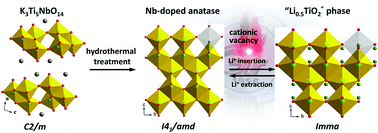Ask for a reprint
email :
* Give your email
2018
ACL
|
F.Lu, Q.Chen, S.Gen, M.Allix, H.Wu, Q.Huang, X.Kuang, *, 'Innovative lithium storage enhancement in cation- de fi cient anatase via layered oxide hydrothermal transformation', J. Mater. Chem. A 6 24232 (2018) doi:10.1039/c8ta07605g
The soft-chemistry synthetic routes of anatase phases for energy conversion and storage usually employ
expensive and air-sensitive amorphous alkoxides, which hardly access the electrochemically active
cationic vacancy defects in the cationic donor-substituted anatase compositions. Here we demonstrate
an innovative way of using layered K
3
Ti
5
NbO
14
as a cost-e
ff
ectively crystalline precursor to synthesize
cation-de
fi
cient Nb-doped TiO
2
(NTO, formulated as Ti
0.8
Nb
0.16
,
0.04
O
2
) anatase by a one-pot
hydrothermal route. When used as an anode in lithium ion batteries, the NTO electrode displayed initial
discharge and charge capacities of 618 and 384.6 mA h g
�
1
at a current density of 0.2C respectively,
with a remarkable discharge capacity of
�
246.8 mA h g
�
1
retained after 100 cycles, representing the
highest value among those reported for Nb-doped TiO
2
anatases at low current density. A discharge
capacity of 137.1 mA h g
�
1
was obtained even at a high current density of 2C. A full cell, fabricated using
the NTO electrode as the anode and a commercial LiCoO
2
cathode, is shown to deliver a discharge
capacity of 220.2 mA h g
�
1
after 57 cycles, which exceeds those of most previously reported full cells
based on the TiO
2
anode and makes this NTO material a promising anode candidate for LIBs. These
results present a practical synthetic strategy for tuning cationic vacancies through aliovalent cationic
substitution to improve the electrochemical performance of actual LIBs and possibly to develop further
relevant devices.
|

|